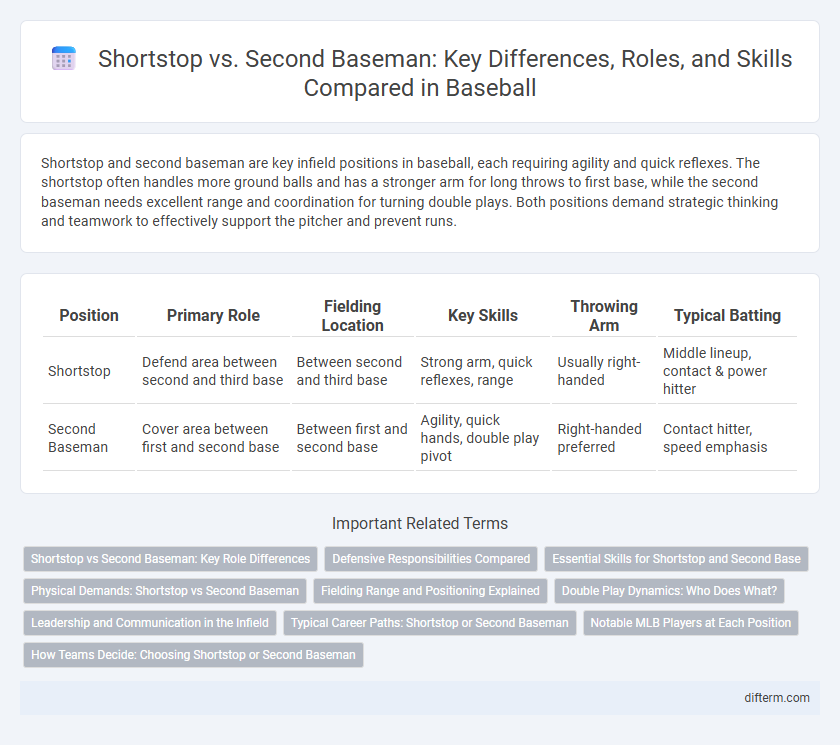Shortstop and second baseman are key infield positions in baseball, each requiring agility and quick reflexes. The shortstop often handles more ground balls and has a stronger arm for long throws to first base, while the second baseman needs excellent range and coordination for turning double plays. Both positions demand strategic thinking and teamwork to effectively support the pitcher and prevent runs.
Table of Comparison
| Position | Primary Role | Fielding Location | Key Skills | Throwing Arm | Typical Batting |
|---|---|---|---|---|---|
| Shortstop | Defend area between second and third base | Between second and third base | Strong arm, quick reflexes, range | Usually right-handed | Middle lineup, contact & power hitter |
| Second Baseman | Cover area between first and second base | Between first and second base | Agility, quick hands, double play pivot | Right-handed preferred | Contact hitter, speed emphasis |
Shortstop vs Second Baseman: Key Role Differences
The shortstop plays a central role in fielding, positioned between second and third base, responsible for covering more ground and often initiating double plays due to their strong arm and agility. The second baseman typically covers the area between first and second base with quicker throws and is essential in turning double plays by fielding ground balls and pivoting. Both positions require quick reflexes and coordination, but the shortstop's role demands greater range and defensive versatility.
Defensive Responsibilities Compared
Shortstops are primarily responsible for covering the area between second and third base, fielding ground balls, turning double plays, and serving as the infield's defensive leader due to their range and arm strength. Second basemen typically handle balls hit between first and second base, pivot on double plays, and provide backup coverage for first base, requiring quick hands and agility. Both positions demand strong fielding skills, but shortstops often have more complex defensive duties and cover greater ground within the infield.
Essential Skills for Shortstop and Second Base
Shortstops require exceptional range, quick reflexes, and strong arm strength to cover more ground and execute long throws to first base. Second basemen prioritize agility, smooth footwork, and quick hands to turn double plays with efficiency and handle short hops reliably. Both positions demand sharp instincts and precise communication to coordinate infield defense effectively.
Physical Demands: Shortstop vs Second Baseman
Shortstops require exceptional agility and range due to frequent ground balls and long throws across the diamond, demanding high levels of speed and arm strength. Second basemen emphasize quick reflexes and lateral movement for turning double plays and fielding short hops, prioritizing agility and balance over arm power. Both positions necessitate strong hand-eye coordination and endurance to maintain consistent defensive performance throughout the game.
Fielding Range and Positioning Explained
Shortstops possess a wider fielding range due to their central infield position, allowing them to cover more ground between second and third base. Second basemen typically have shorter range but compensate with quicker pivots and throws to first base, optimizing double-play opportunities. Positioning varies with game situations, as shortstops shift deeper for line drives while second basemen position closer to first base to defend against bunts and grounders.
Double Play Dynamics: Who Does What?
In double play dynamics, the shortstop primarily fields ground balls and delivers quick, accurate throws to the second baseman at second base. The second baseman's key role involves receiving the ball from the shortstop, tagging or stepping on second base for the first out, and quickly throwing to first base to complete the double play. Coordination, speed, and precise timing between the shortstop and second baseman are crucial for effectively turning double plays and minimizing opponents' scoring opportunities.
Leadership and Communication in the Infield
The shortstop often serves as the infield leader, orchestrating defensive alignments and ensuring seamless communication with the second baseman. Effective communication between a shortstop and second baseman is crucial for turning double plays and covering bases, requiring precise timing and mutual trust. Strong leadership from the shortstop fosters coordination, enhances situational awareness, and minimizes errors in high-pressure moments.
Typical Career Paths: Shortstop or Second Baseman
Shortstops often transition to positions requiring strong arm strength and range, such as third base or outfield, as their career progresses due to physical demands. Second basemen typically develop into versatile infielders or utility players, capitalizing on agility and quick defensive reflexes. Both positions serve as foundational roles for players aiming to extend their careers through adaptability and defensive consistency.
Notable MLB Players at Each Position
Notable MLB shortstops include Derek Jeter, known for his clutch hitting and leadership, and Ozzie Smith, celebrated for his defensive wizardry. Renowned second basemen feature Roberto Alomar, a two-time Gold Glove winner with exceptional range, and Ryne Sandberg, who combined power with agility. These players exemplify the unique skill sets and strategic importance of each infield position.
How Teams Decide: Choosing Shortstop or Second Baseman
Teams decide between shortstop and second baseman based on defensive range, arm strength, and double-play pivot skills, with shortstops typically requiring greater agility and stronger throws across the diamond. Evaluations include infielders' ability to cover ground, youth athleticism, and situational awareness to optimize infield dynamics and prevent runs. Analytics metrics such as Ultimate Zone Rating (UZR) and Defensive Runs Saved (DRS) guide management in positioning players where their defensive impact maximizes team performance.
shortstop vs second baseman Infographic

 difterm.com
difterm.com